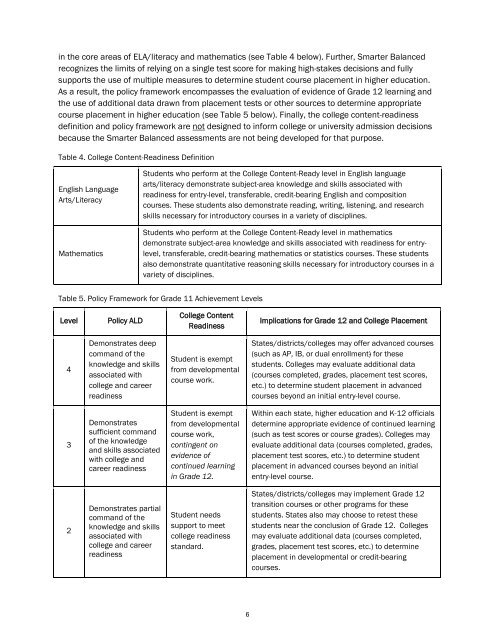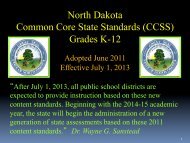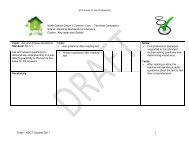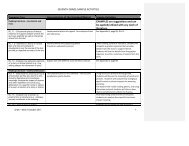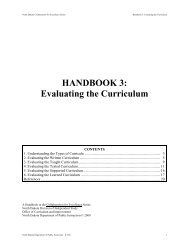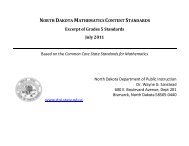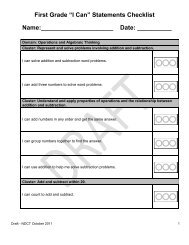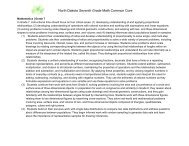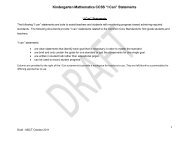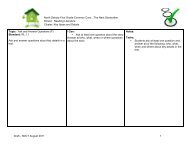SBAC Achievement Level Descriptors, Grade 4 - ND Curriculum ...
SBAC Achievement Level Descriptors, Grade 4 - ND Curriculum ...
SBAC Achievement Level Descriptors, Grade 4 - ND Curriculum ...
You also want an ePaper? Increase the reach of your titles
YUMPU automatically turns print PDFs into web optimized ePapers that Google loves.
in the core areas of ELA/literacy and mathematics (see Table 4 below). Further, Smarter Balancedrecognizes the limits of relying on a single test score for making high-stakes decisions and fullysupports the use of multiple measures to determine student course placement in higher education.As a result, the policy framework encompasses the evaluation of evidence of <strong>Grade</strong> 12 learning andthe use of additional data drawn from placement tests or other sources to determine appropriatecourse placement in higher education (see Table 5 below). Finally, the college content-readinessdefinition and policy framework are not designed to inform college or university admission decisionsbecause the Smarter Balanced assessments are not being developed for that purpose.Table 4. College Content-Readiness DefinitionEnglish LanguageArts/LiteracyMathematicsStudents who perform at the College Content-Ready level in English languagearts/literacy demonstrate subject-area knowledge and skills associated withreadiness for entry-level, transferable, credit-bearing English and compositioncourses. These students also demonstrate reading, writing, listening, and researchskills necessary for introductory courses in a variety of disciplines.Students who perform at the College Content-Ready level in mathematicsdemonstrate subject-area knowledge and skills associated with readiness for entrylevel,transferable, credit-bearing mathematics or statistics courses. These studentsalso demonstrate quantitative reasoning skills necessary for introductory courses in avariety of disciplines.Table 5. Policy Framework for <strong>Grade</strong> 11 <strong>Achievement</strong> <strong>Level</strong>s<strong>Level</strong>Policy ALDCollege ContentReadinessImplications for <strong>Grade</strong> 12 and College Placement4Demonstrates deepcommand of theknowledge and skillsassociated withcollege and careerreadinessStudent is exemptfrom developmentalcourse work.States/districts/colleges may offer advanced courses(such as AP, IB, or dual enrollment) for thesestudents. Colleges may evaluate additional data(courses completed, grades, placement test scores,etc.) to determine student placement in advancedcourses beyond an initial entry-level course.3Demonstratessufficient commandof the knowledgeand skills associatedwith college andcareer readinessStudent is exemptfrom developmentalcourse work,contingent onevidence ofcontinued learningin <strong>Grade</strong> 12.Within each state, higher education and K-12 officialsdetermine appropriate evidence of continued learning(such as test scores or course grades). Colleges mayevaluate additional data (courses completed, grades,placement test scores, etc.) to determine studentplacement in advanced courses beyond an initialentry-level course.2Demonstrates partialcommand of theknowledge and skillsassociated withcollege and careerreadinessStudent needssupport to meetcollege readinessstandard.States/districts/colleges may implement <strong>Grade</strong> 12transition courses or other programs for thesestudents. States also may choose to retest thesestudents near the conclusion of <strong>Grade</strong> 12. Collegesmay evaluate additional data (courses completed,grades, placement test scores, etc.) to determineplacement in developmental or credit-bearingcourses.6


